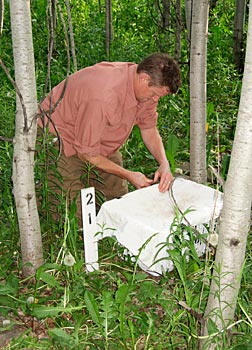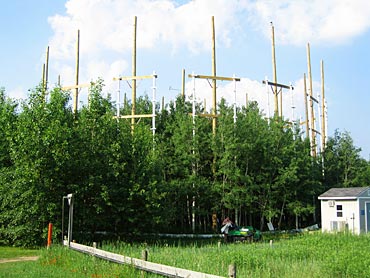Hungry insects leave clues to impacts of climate change
Harshaw, Wis. — A boardwalk beckons into the stand of trees, pleasantly cool on a hot summer morning — where it becomes immediately clear that this is no ordinary forest. Odd metal and plastic contraptions adorn trunks and dangle from branches, scaffolding looms overhead, and numbered markers and baskets lie scattered on the ground.

John Couture collects samples of fallen leaves, insect waste, and other debris at the Harshaw site to study how atmospheric and climate changes may affect insect populations and forests.
Photo: Jill Sakai
Unperturbed, John Couture heads for the nearest basket, wrapping up a cotton sheet containing scraps of leaves and what look like grains of sand. A doctoral student working with entomologist Rick Lindroth in the University of Wisconsin–Madison’s College of Agricultural and Life Sciences, he will read these bits of detritus — evidence of hungry insects at work in the forest — for clues to how a changing climate may affect Wisconsin’s landscape.
The 12 conspicuous patches of aspen, birch and maple in this neck of Northwoods form a state-of-the-art outdoor laboratory for researchers from around the U.S. and world to study the likely impacts of climate change on northern temperate forests.
Called the Aspen Free Air Carbon Dioxide Enrichment (Aspen FACE) experiment, this collaborative effort among several institutions, including the U.S. Department of Energy (DOE), U.S. Forest Service (USFS), Canadian Forest Service and several universities worldwide, is a large-scale and long-term environmental study located in the Harshaw Experimental Forest, just 20 minutes drive from Kemp Natural Resources Station in Woodruff, Wis.
Each 90-foot-diameter circle of trees is surrounded by a ring of towering ventpipes that control the local levels of carbon dioxide and ozone, two air pollutants expected to increase during the next century. For more than 10 years, researchers from the partner institutions have studied how these forest communities respond to elevated levels of these gases.
What makes this forested laboratory so special is that each ring contains far more than just trees. Natural ecosystems include numerous interwoven levels — plants, animals, soil, bacteria — and are difficult to mimic in a lab, especially because scientists rarely know what all the components are, Couture says. At Aspen FACE, scientists can ask research questions within a natural environmental context.

UW-Madison graduate student John Couture prepares to enter one of 12 circles of trees that make up the long-term forest environmental study site in Harshaw, Wis. Aided by a computer-controlled gas venting system that controls local levels of carbon dioxide and ozone, researchers are examining the effects of these air pollutants on forest ecosystems.
Insects, though small, play a big role in forests and are the predominant animals in most forest ecosystems, far outnumbering more visible species like deer, Couture says. He and postdoctoral fellow Tim Meehan, both funded by the DOE, collect and decipher the clues insects leave behind to study how increasing levels of carbon dioxide and ozone affect plant-eating insects and their habitats.
"When you add ozone or carbon dioxide to the air, how does it affect the growth of trees and the chemical nature of their leaves and the activity of insects that eat them?" asks Meehan. "How is the forest ecosystem going to work in the future?"
As herbivorous insects munch on plants, they drop bits of leaves, their waste — called frass — and even their bodies once they die, which all become part of the soil. In turn, the soil nourishes new plant growth, which feeds more hungry bugs. "Insects can play a central role in contributing to what falls onto the forest floor," says Couture.
He and Meehan take leaf samples and stretch sheets over laundry baskets on the ground to catch falling debris that would normally feed soil microbes and plants.
Back at the Lindroth lab in Madison, they will analyze their catch, typically a mix of partially nibbled leaves, sand-like frass and dead bugs, to determine what is in the leaves and how much and what the insects are eating. By comparing the patterns from different environments, they hope to predict how a changing global atmosphere may impact Wisconsin’s forest communities and their six-legged residents.
At the Aspen FACE site, effects of the greenhouse gases become obvious immediately upon stepping into the different rings. The forest patches receiving extra carbon dioxide have large, tall trees and a dense leaf canopy, under which a few scattered grasses compete for the little light that trickles through to the ground. Step next into a circle with elevated ozone, and the trees are shorter, with smaller trunks and a lower, lacier canopy. The ring is bright and sunny and the ground is hidden beneath thick understory growth two or more feet high.
Other differences are not so obvious. As Couture navigates the maze of trees and sampling equipment in each ring, he talks about how the different gases affect the chemical properties of leaves, causing changes in the plants’ nutrient contents and natural defensive chemicals that deter insect predators. "The atmosphere influences trees, which influence insects, which influence what gets put in the ground," he says.
The interdependence of the forest communities is clearly visible in this living laboratory — nothing exists in isolation.
The Aspen FACE experiment is funded principally by the Office of Science (OBER) of the DOE. Additional support comes from the USFS Global Change Program, Michigan Technological University, the Canadian Forest Service and the USFS North Central Research Station. More information about the experiment can be found at http://aspenface.mtu.edu.




